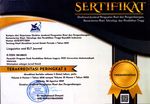Correlation Between Speaking Strategies of EFL Undergraduates and Their Thinking Styles
Abstract
The present study was conducted to analyze the correlation between speaking strategies of EFL undergraduates and their thinking styles. The researcher used chi-square test analysis which 47 sophomore students (34 female and 13 male) in the English department at the state university of Surabaya. In collecting the data, this study used two adopted questionnaires that was developed from Oxford’s LLS speaking 20 items (1990) and Sternberg and Wagner’s (1992) TSI 65 items included among the side of background information on their gender. As concerns on the analysis, this study found that there were no significant correlation between the speaking strategies of EFL undergraduates and their gender (X2= 1.736), the thinking styles of EFL undergraduates and their gender (X2= 1.043), speaking strategies and thinking styles of EFL undergraduates and their gender (X2= 2.839).
Keywords
Full Text:
PDFReferences
Alhaysony, M. (2017). Language Learning Strategies Use by Saudi EFL Students: The Effect of Duration of English Language Study and Gender. Theory and Practice in Language Studies, 7(1), 18. https://doi.org/10.17507/tpls.0701.03
Aliakbari, M., & Qasemi, N. (2012). On the relationship between Iranian EFL learners’ learning style preference and their gender, proficiency level and achievement score. International Journal of Pedagogies and Learning, 7(3), 275–283. https://doi.org/10.5172/ijpl.2012.7.3.275
Alimirzaloo, E., & Hashemnezhad, H. (2015). An investigation on the relationship between critical thinking skills, language learning strategies, and thinking styles of Iranian EFL learners. International Journal of Research Studies in Language Learning, 4(5), 57–74. https://doi.org/10.5861/ijrsll.2015.1106
Alkahtani, S. (2016). Language Learning Strategies Among Saudi Efl College Students and Their Relationship To Students’ Perceptual Learning Style, Gender, Academic Major and Proficiency Level. Doctoral Dissertations. https://trace.tennessee.edu/utk_graddiss/4122
Andrew, D. Cohen, Strategies in learning and using a second language. Harlow, Essex: Longman.1998
Apriani, F., Vianty, M., Education, E., & Program, S. (2017). Students’ Thinking Styles and Its Relation to Their Language Learning Strategies. 4(1), 59–70. https://ejournal.unsri.ac.id/index.php/jenglish/article/view/5621
Ary, D., Jacobs, L. C., Sorensen, C., & Razavieh, A. (2014). Introduction to Research in Education.
Bernardo, A. B. I., Zhang, L., & Carmelo, M. (n.d.). The Journal of Genetic Psychology : Research and Theory on Human Development Thinking Styles and Academic Achievement Among Filipino Students. November 2014, 37–41. https://doi.org/10.1080/00221320209598674
Burns, A. & Joyce, H. 1997. Focus on Speaking. Sydney: Macquire University Press.
Chamot, A. U. (2005). Language learning strategy instruction: Current issues and research. Annual Review of Applied Linguistics, 25, 112–130. https://doi.org/10.1017/S0267190505000061
Cohen, A. D (1998) Strategies in Learning and using a second Language. Cambridge: Cambridge University Press.
EF Education First. (2021). English Profiency Index. Ef Epi, 1–40.
Gavriilidou, Z., & Papanis, A. (2010). A preliminary study of learning strategies in foreign language instruction : Students’ beliefs about strategy use 1. 1985, 1267–1271.
Green, J. M., & Oxford, R. (1995). A Closer Look at Learning Strategies, L2 Proficiency, and Gender. TESOL Quarterly, 29(2), 261. https://doi.org/10.2307/3587625
Keppel, G. (1993). Design and Analysis: A Researcher’s Handbook. Pearson.
Khalil, A. (2005). Assessment of language learning strategies used by palestinian EFL learners. Foreign Language Annals, 38(1), 108–117. https://doi.org/10.1111/j.1944-9720.2005.tb02458.x
Khodae Balestane, M., Hashemnezhad, H., & Javidi, S. (2012). The relationship between language learning strategies and thinking styles of Iranian EFL learners. International Journal of Research Studies in Language Learning, 2(3), 3–19. https://doi.org/10.5861/ijrsll.2012.186
Mahmood, K. B. (2013) the relationship between language learning strategies and thinking style of Iranian EFL learners international journal of research studies in language. 3-19.
McMullen, M. G. (2009). Using language learning strategies to improve the writing skills of Saudi EFL students: Will it really work? System, 37(3), 418–433. https://doi.org/10.1016/j.system.2009.05.001
Negari, G. M. (2013). The Relationship among Autonomy, Thinking Styles and Language Learning Strategy Use in Iranian EFL Learners. 5(1). https://doi.org/10.5296/ijl.v5i1.3320
Nisbet, D. L., Tindall, E. R., & Arroyo, A. A. (2005). Language learning strategies and English proficiency of Chinese university students. Foreign Language Annals, 38(1), 100–107. https://doi.org/10.1111/j.1944-9720.2005.tb02457.x
O’Malley, J. M. & Chamot, A. U, Learning strategies in second language Acquisition, 1990, Cambridge: Cambridge University Press, page 188
Oxford, R. L. Language Learning Strategies: What Every Teacher Should Know, 1990, New York: Newbury House, page 8
OXFORD, R. 1994. Language learning strategies: An update. Online Resources: Digests.
OXFORD, R., & CROOKALL, D. (1989). Research on Language Learning Strategies: Methods, Findings, and Instructional Issues. The Modern Language Journal, 73(4), 404–419. https://doi.org/10.1111/j.1540-4781.1989.tb05321.x
OXFORD, R., & NYIKOS, M. (1989). Variables Affecting Choice of Language Learning Strategies by University Students. The Modern Language Journal, 73(3), 291–300. https://doi.org/10.1111/j.1540-4781.1989.tb06367.x
Radwan, A. A. (n.d.). Effects of L2 proficiency and gender on choice of language learning.
Richards, J. C. (2006). Communicative language teaching today. Cambridge, UK: Cambridge University Press.
Rigney, JW (1978). Learning Strategies: A theoretical perspective. In H F O’Neil (Jr) (ed) 165-205
Rodgers, T. S. (2001). Language teaching methodology. Washington, DC: Centre for Applied Linguistics.
Salahshour, F., Sharifi, M., & Salahshour, N. (2013). The Relationship between Language Learning Strategy Use, Language Proficiency Level and Learner Gender. Procedia - Social and Behavioral Sciences, 70(1957), 634–643. https://doi.org/10.1016/j.sbspro.2013.01.103
Shan, C. (2009). University Freshmen in Taiwan. Tesol Quarterly, 43(2), 255–280.
Sheorey, R., & Mokhtari, K. (2001). Differences in the metacognitive awareness of reading strategies among native and non-native readers. System, 29(4), 431–449. https://doi.org/10.1016/S0346-251X(01)00039-2
Stenberg, R. J., & Wagner, R. K. (1992). Thinking Styles Inventory. (Unpublished Test, Yale University).
Stenberg, R. J. (1997). Thinking styles. NY: Cambridge University Press.
Stenberg, R. J., Wagner, R. K., & Zhang, L-F. (2003). Thinking Styles Inventory-Revised. (Unpublished Test, Yale University).
Wharton, G. (2000). Language Learning Strategy Use of Bilingual Foreign Language Learners in Singapore. Language Learning, 50(2), 203–243. https://doi.org/10.1111/0023-8333.00117
Zhang, L. F. (2001). Approaches and thinking styles in teaching. Journal of Psychology: Interdisciplinary and Applied, 135(5), 547–561. https://doi.org/10.1080/00223980109603718
DOI: https://doi.org/10.31764/leltj.v10i1.9100
Refbacks
- There are currently no refbacks.
Copyright (c) 2022 Linguistics and English Language Teaching Journal

This work is licensed under a Creative Commons Attribution-ShareAlike 4.0 International License.
_____________________________________________________
Linguistics and ELT Journal
p-ISSN 2339-2940 | e-ISSN 2614-8633

LELTJ is licensed under a Creative Commons Attribution-ShareAlike 4.0 International License.
_____________________________________________________
LELTJ is abstracting & indexing in the following databases:
_____________________________________________________
LELTJ Editorial Office:













